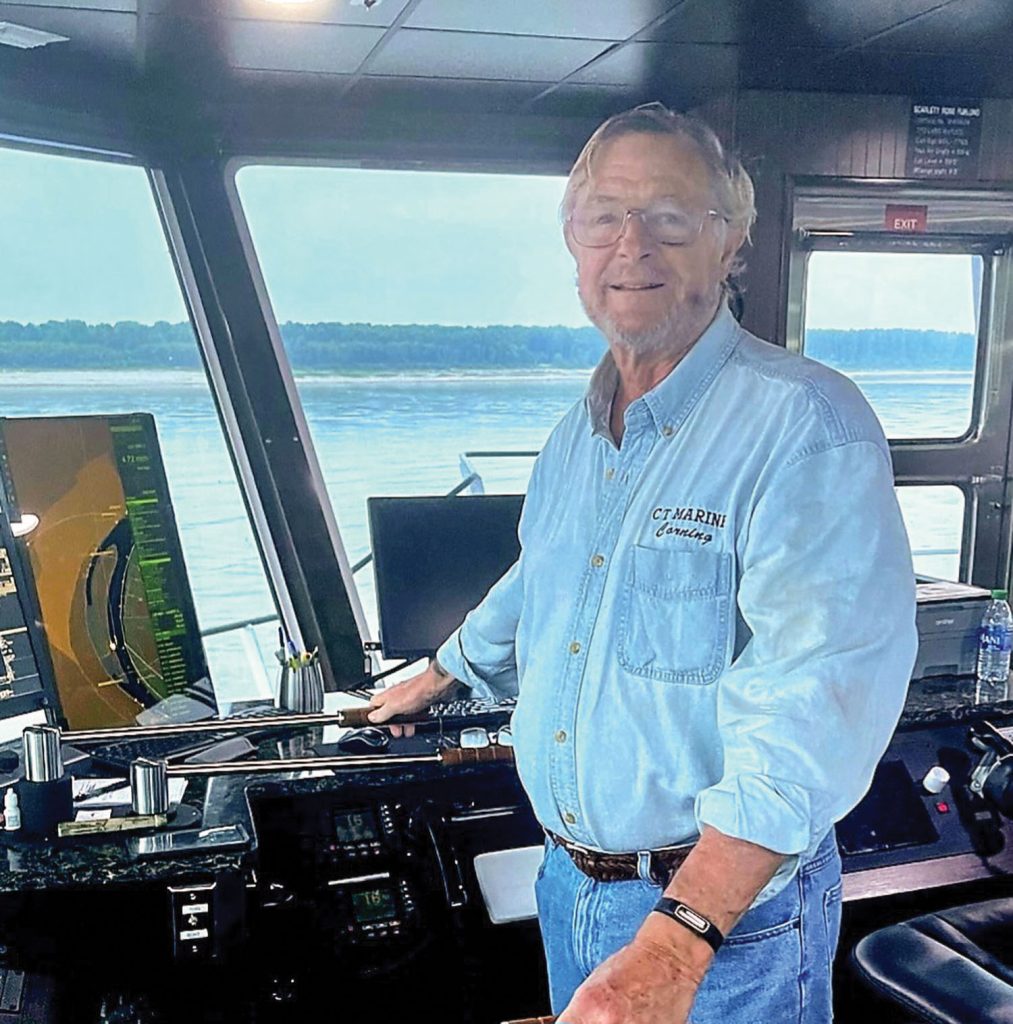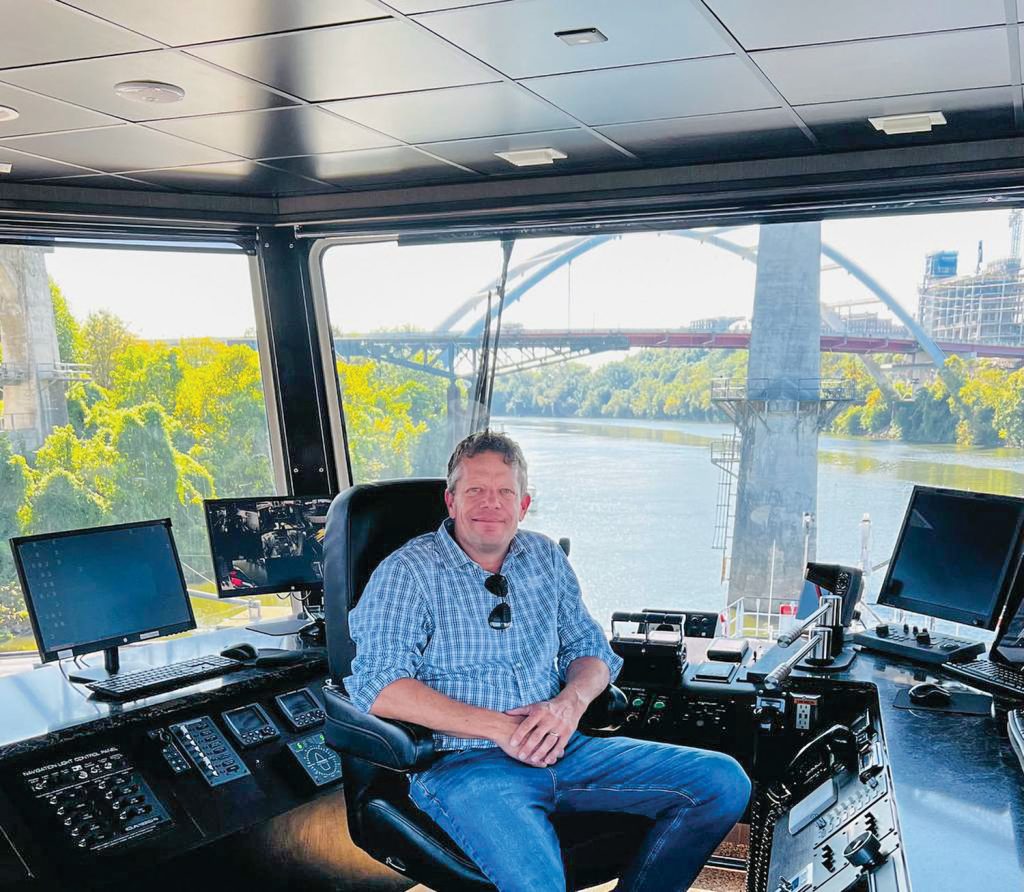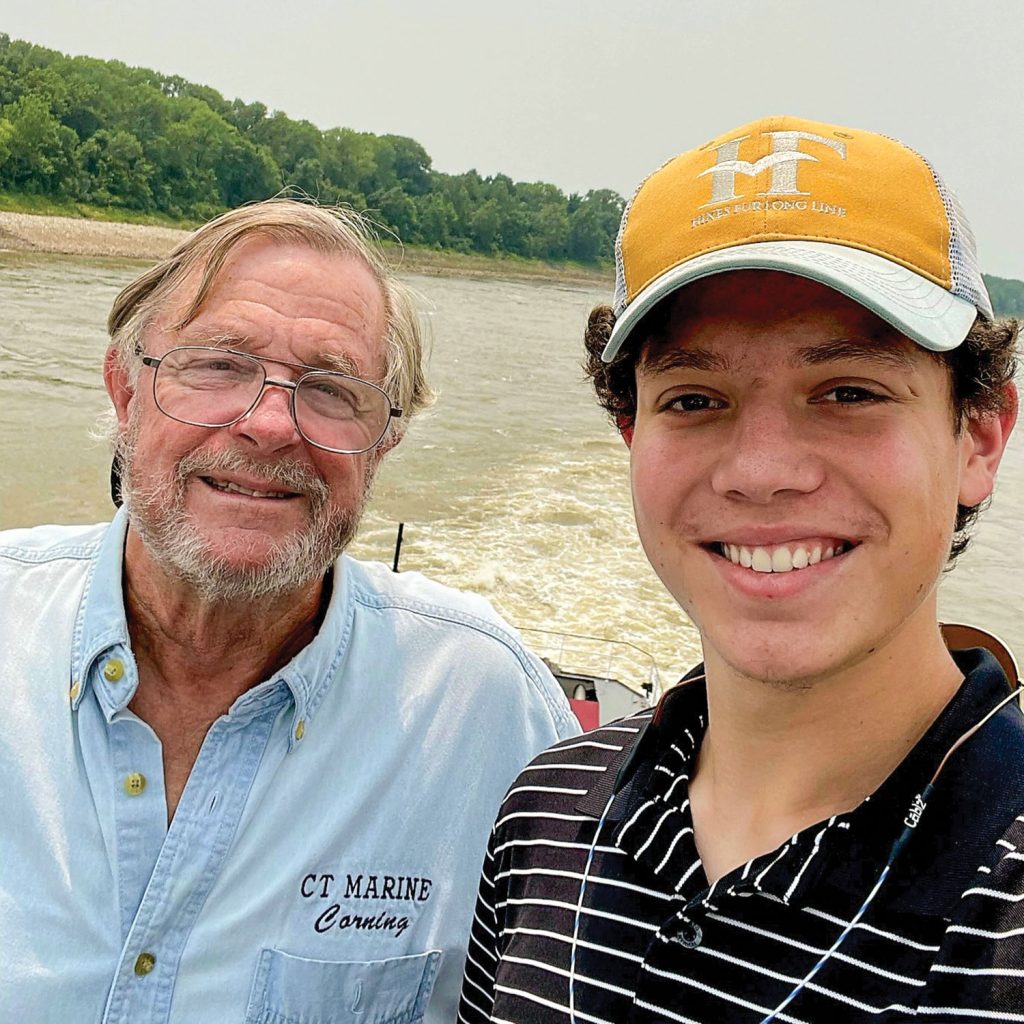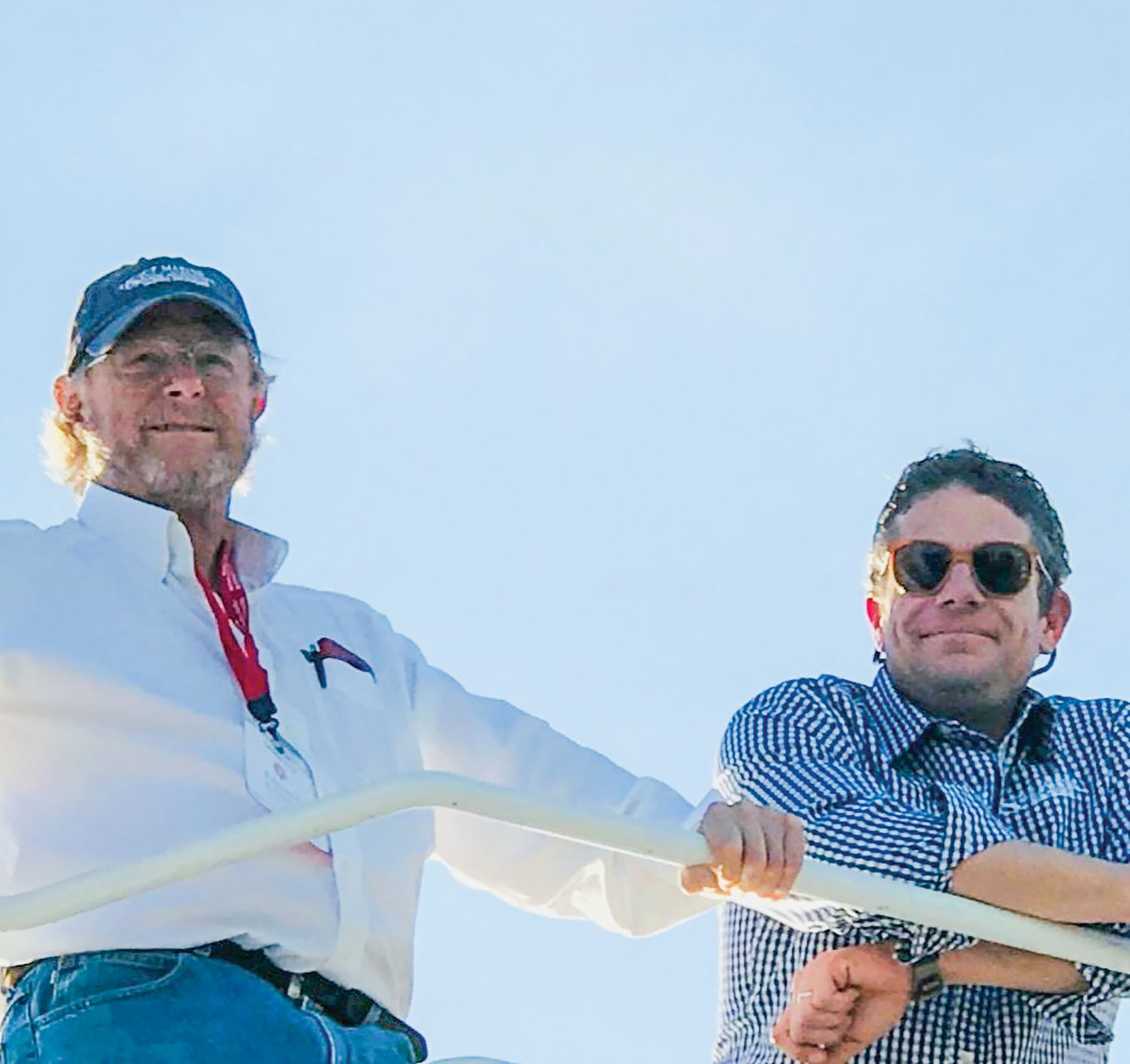Three generations of Townsend men are behind CT Marine, the company that has designed every towboat on the Mississippi River more powerful than 6,600 hp. since 1988.
Capt. Corning Townsend III, 82, of Edgecomb, Maine, founded the company in 1978. He transferred ownership to his son, Christian Townsend, 54, in 2017. Now Christian’s son, Scout, 19, models propulsion systems in between his classes at the University of Michigan.
Background
It all started out with a love of sailing, Corning Townsend said. At the age of 14, he began working his summers as a galley boy on the brigantine Yankee. Mentored by Capt. Irving Johnson, he rose to third mate in three years aboard.
Following a stint in the merchant marine, he enrolled at the University of Michigan. From 1960 to 1967, he worked at the university’s ship model basin, progressing from carriage driver/helper to interim director following the death of Jim Moss.
He graduated with a Bachelor of Science degree in naval architecture and master’s degrees in naval architecture and marine engineering. He also holds a U.S. Coast Guard 100-ton master’s license for power and sail on both inland rivers and oceans.
Corning Townsend said that while he knew his way around a boat, his college classes were an awakening as he went in thinking naval architecture was mostly about drawing pictures of boats and would be similar to art.
“I sort of thought naval architecture was drawing with charcoal and maybe drawing sailboats, and after three years I’d never picked up anything to draw with and had done nothing but math,” he said. “If they had called it naval engineering, I might not have ever started.”

After completing his education, he worked at the Netherlands Ship Model Basin as guest scientific officer for two years, performing hydrodynamic research and testing shallow-draft vessels. As a project manager, Corning tested model performance for Dravo, Jeffboat, St. Louis Ship and Nashville Bridge, the four major American towboat builders at the time, and met many of the people who would later become his clients.
He then joined C.R. Horton, working for a few years designing tugs, barges and river towboats under the tutelage of Clancy Horton, who is credited with developing the modern towboat.
Horton had gone to Germany in the 1930s to study the kort nozzle, invented by Ludwig Kort. He brought the patented (type 19A) nozzle to the United States in 1937 as chief naval architect at Dravo and installed it on the Dravo Pioneer. Corning Townsend worked for Horton for eight years starting in 1968. During that time, they designed the type 37 nozzle for a pair of ship-docking tugs in Aruba, he said. That design was used on river towboats for the next 15 years as it provided better backing and flanking with much less vibration astern, he said.
Continuing Innovations
Over the years, Corning Townsend has seen plenty of changes in the industry.
“When I started, all the drawings were ink on velum, and all of the calculations were made with a hand-cranked adding machine,” he said. “That has changed to 2 and 3D CAD (Computer Assisted Design) drawings that are done on your computer and printed out on paper or maybe never printed out, and of course all the calculations are on the computer with applications.”
In 1976, Corning formed his first company, Townsend Marine Design. He changed the name after hiring some other naval architects.
At first, the company focused on designing ocean tugs and large ATB barges, but following the downturn in the oil market in the 1980s, the elder Townsend switched his focus to shallow-draft, high-horsepower pushboats for rivers. While some of those designs were for the American market, other boats were for faraway destinations, like the Amazon and Volga rivers.
Notable achievements along the way included the first articulated tug and barge (ATB) and the design and testing of the first vapor-recovery system on both inland and ocean barges in the United States.
CT Marine also holds patents involving improved steering on shallow-draft towboats, including a twin differential (TwinDIFF) rudder system that uses two rudders for steering rather than one and two different nozzle systems, the CT28, which launched in 1998, and the CTSL, which debuted in 2009. These nozzles have been used on higher-horsepower boats on the Mississippi River for 25 years. CT Marine also developed the CT EZFlow strut, a strut that is both canted and twisted to minimize nozzle erosion.
Another Generation
Christian Townsend began working with CT Marine at age 11, visiting shipyards with Corning and folding blueprints in the barn that housed the office of designers. He joined the family business in 1988, doing the drafting for a lot of vapor-recovery projects and oceangoing barges while in college at Purdue University. While majoring in structural engineering, Christian always had the river as an interest, and he completed internships with Sabine Towing in Port Arthur, Texas, and Galveston Shipbuilding in Galveston. Christian started the computer aided design/cutting program at the shipyard and helped to design the first computer-cut 297-foot barge. He went to work full-time for his father in 1992.

While Christian Townsend officially took over the business six years ago, he said his father remains heavily involved. While saying that his own primary contribution is the distinctive design that characterizes the look of their boats, Christian said he talks to his father about naval architecture nearly every day.
Corning Townsend said his son is a very capable designer and notes in particular his “great imagination” for the use of restricted space and a profound understanding of the importance of structural continuity. He added that while he personally enjoys “broad-brush design and engineering,” Christian is much more detail-oriented.
The combination of their strengths makes for something special, both men said, and they rarely take a break.
“We really work seven days a week, 365 days a year,” Christian Townsend said. “It just never stops. Somebody’s always talking about towboats.”
To date, CT Marine has had 1,857 towboat-related projects, he said. Some are small, from repairing a propeller, remedying a vibration or adding a pilothouse, and some are newbuilds.
Christian Townsend figures he’s been involved in about half of the towboat projects since he joined the company. He’s proud of the brand CT Marine has built and the continued effort to evolve modern towboat design.
“Our boats don’t vibrate,” he said.
While that may seem like a small thing, he noted that for mariners who ride the boats for a month or more at a time, it makes a big difference in retaining crews.
“After 55 years of development, we’ve really honed in on what’s best for a towboat,” he said.
Additionally, eight years ago, CT Marine partnered with Buoyancy Consultants in Goa, India, forming Hyperion Marine Group, which handles the detail and production design for many of the largest marine companies in the world.
The Third Generation
The company is poised to grow again with the involvement of the third generation of Townsend men. Scout Townsend knew from a young age that he wanted to go to the University of Michigan like his grandfather, whom he calls Cornpop. He had his grandfather’s university flag in his bedroom when he was only 5.
“He’s been modeling for me since he was 14 and now is in charge of the 3D propulsion modeling for Hyperion,” Christian Townsend said. Scout also handles the General Hydrostatics of the new builds following certification from GHS.
Christian remembers showing Scout the CAD program he was using years ago.
“Back then it was like a video game for him,” he said. “He picked it up in a day.”
Scout said his love of naval architecture goes back as far as he can remember. He loved watching his dad on the computer, drawing boats, he said, adding, “I always thought it was super cool.”
In fourth grade, he said, he remembers an after-school activity making wooden dinghies, which added to his ambition. Then in sixth grade he visited the University of Michigan, where Corning was being honored in UofM’s 100th anniversary celebration. Scout attended his first home game with his grandfather and visited the university’s ship model basin while there.
Scout said he started out using CAD to try to recreate his father’s paper drawings to exact scale.
“For me it was pretty easy to start doing,” he said. “I kind of just taught it to myself.”
While in eighth grade, he visited his grandfather’s house and took a look at his General Hydrostatics program, quickly learning to use that, also.
“I’ve always liked math, and naval architecture is such a unique problem to try to solve,” he said.

Scout’s first real project for company use was designing rudders that were 3D printed and put on a remote-control boat for a trade show.
While clearly with a passion for the family business, Scout said that for now schoolwork comes first.
“I do a little work on the side,” he said. “Wherever I have spare time, I try to help as I can.”
It’s no small job, however. Some of his more recent work included completing the propulsion modeling for the Hines Furlong towboat the Scarlett Rose Furlong.
Scout said he enjoys taking what he’s learning in his classes and thinking about how they could be applied in the business. He also has taken on organizing some of the voluminous information CT Marine has collected over the decades. He took his grandfather’s “Towboat Bible,” with formulas and information originally put together in an Excel spreadsheet, added explanations in Word and cross-referenced it with names of clients and projects to create a reference document, for example.
“I couldn’t imagine being a doctor or a lawyer or anything like that,” Scout Townsend said. “I think naval architecture is unique, one of the coolest jobs you can do. There are not many people who do it.”
Moving Toward The Future
CT Marine puts about 20,000 man-hours of design into the typical towboat, Christian said. The boats the company builds these days are more like five-star hotels, packed with the latest innovations to help improve crew safety and retention as well as to increase efficiency, making it possible for them to travel more miles per day and burn less fuel.
CT Marine and Hyperion Marine Group currently have a team of 85 in Goa, India, who handle various engineering for tugs, ferries, ATBs and dredges. On the U.S. side, the company is headquartered in Portland, Maine, and it is growing by adding a business development specialist and another naval architect in the coming year.
Through it all, the Townsend men remain at the core of their business.
Corning Townsend said he still dreams about towboats a few nights a week, and Christian said work inevitably spills over into holidays, when they are all together.
“If we’re not talking about University of Michigan football,” he said, “we’re probably talking about boats.”
Caption for top photo: Corning and Christian Townsend. (Photo courtesy of CT Marine)



